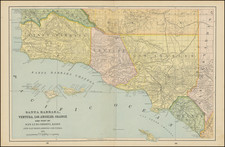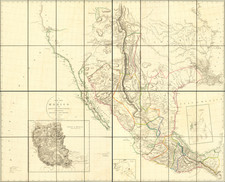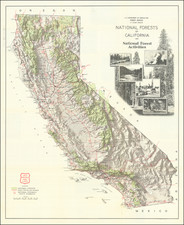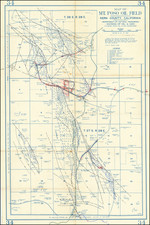Rare early petroleum pamphlet and map of the Santa Barbara area.
Nice example of A Description of the Recently Discovered Petroleum Region in California. With a Report on the Same by Professor Silliman, published in 1865. As noted in the Heckrotte Catalog
This rare little prospectus discusses all aspects of extracting petroleum, a recent source of wealth in the Santa Barbara area. Includes a paragraph on labor (discussing Chinamen who were industrious but faced a backlash), plus discussions on the market for oil and much on geology, and of course the proposed earnings for those investing in the company. The folding map is "Map Representing Locality of the Ojai Ranch in Santa Barbara County, California, belonging to the California Petroleum Company" (58x39 cm). The map shows the coast from Pt. Concepcion to San Pedro Bay at a scale of 6 miles to an inch. Ranchos are shown. It has an inset of the Ojai Basin. The folding diagram shows an "Ideal Section from Buenaventura to Mupu Arroyo." Warren Heckrotte comments that "This the second pamphlet and the second by Silliman dealing with oil in California; and the map is regarded as the first to show oil deposits in California. (However, Doolittle's map of Humboldt County, 1865 also shows gas and oil deposits.) The text states that the map was prepared by Thomas Sprague, Surveyor of Santa Barbara County. The text states that the oil outcrops are numbered on the map, but this is not the case."
First edition of Silliman's Second Report on oil in California, which includes a large folding map of the "OJAI Ranch in Santa Barbara County ... Property of The California Petroleum Company," and one folding chart. iii, [1], 24 pp. 1 vols. 8vo.
Also covers area in what is now Ventura County.
The map includes an index to properties and inset of "Map of the basin of Ojai: compiled from surveys made by G.H. Thompson, U.S. Dep. Surveyor, by J.H. Wildes, principal draftsman to U.S. Sur. Genl., California.
Benjamin Silliman Jr. (1816-1885) was a significant figure in 19th-century American science, renowned for his contributions to chemistry and geology, notably in the burgeoning field of petroleum science. The son of a famed chemist and professor at Yale College, Benjamin Silliman Sr., he followed in his father's footsteps and carved out his own distinguished academic and scientific career. Graduating from Yale in 1837, he later became a professor of chemistry at the same institution, where he was instrumental in developing its scientific curriculum and facilities.
Silliman Jr. is perhaps best remembered for his pioneering work in the oil and petroleum industries in the United States. His analytical skills were showcased in 1855 when he conducted one of the first scientific studies of crude oil. Commissioned by the Pennsylvania Rock Oil Company, his work provided a comprehensive chemical analysis of petroleum and helped stimulate the first American oil boom by highlighting oil's potential uses in illumination and lubrication. His report became a cornerstone in the development of the petroleum industry, demonstrating the economic viability of rock oil.
Aside from his scientific pursuits, Silliman Jr. also made notable contributions to the popularization of science through his editorship of the American Journal of Science, founded by his father. His efforts in science education and communication, coupled with his pioneering studies in petroleum, cemented his legacy as a key figure in American science during a period of rapid industrial and technological transformation.

![[ California Petroleum ] A Description of the Recently Discovered Petroleum Region in California. With a Report on the Same [with:] Map Representing Locality of The Ojai Ranch in Santa Barbara County, California, belonging to the California Petroleum Company 1865 By Benjamin Silliman, Jr.](https://storage.googleapis.com/raremaps/img/small/103844.jpg)










![[ Southern California to Grand Canyon / Boulder Dam ] Inexpensive Sky Tours via Western Air Express](https://storage.googleapis.com/raremaps/img/small/76820.jpg)



![[Touring Map of California]](https://storage.googleapis.com/raremaps/img/small/76578.jpg)
